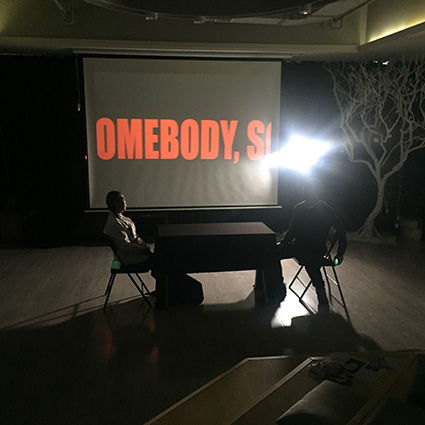
VIDEO SCREAM: NOBODY IS SOMEBODY NOBODY IS NOBODY SOMEBODY IS SOMEBODY SOMEBODY IS NOBODY Each sentence has more than one meaning, each meaning is independent, they are intertwined and parallel to each other. This is my personal reflection, my questioning, and wake-up as possible, no one can say that I am not present, you may be anyone, you may not be anyone, and you may not even be at the scene. In the compulsory social realm environment and directional phenomenon, whether you escape or accept, it is an initiative for the individual. It is the second time that Zhu Yu has hired laborers to perform. Zhu hired a housemaid Zhang Guilang from her neighbor. Zhang has been a housemaid for six years. This piece is based on the dialogue of Abramovich, all the audience who take a mask get a conversation with Zhang, whether they are “SOMEBODY” or “NOBODY”, all they are other people. In this set field, where zhu creates a field in the language of 1D and 2D. Questioned \”SOMEBODY\” in a direct and semi-provocative way, in the art society that where there is the problem lies? When the artist plays a leading role in the social relationship of the food chain and the function of the navigator. Nanny has an eye conversation in “Eye of God” with people. Zhu is trying to establish the basic isomorphic relationship of people, collectively referred to as people with masks.
BIO: Zhu Yu was born on March 8, 1981, in Liushi Town, Wenzhou, Zhejiang Province. In 2008, she graduated from the Video Art Department of Central Academy of Fine Arts of China, and now mainly works and lives in Beijing, Wenzhou, and Shanghai. The artist’s chief mediums are video, installation, and photography. Moveable maps are her current artistic orientation. She says that her works are like looking for markers and relabeling them in a misty forest. Her social upbringing, interpreted as a meridian, while ceaseless in wiping off her immediate past, acts as a coordinate. And where is her latitude of cognition? Liushi is a small Chinese town, where 90% of the inhabitants are engaged in manufacturing electrical appliances. The electrical products are sold all over China and all over the world。 The region is somewhat alienated from the social and political system but in its drive towards modern civilization has continuously been hindered by political constraints and economical ideology. The ideological mindset of the community has undergone a tremendous change but the special geographical environment often triggers some sensitive emotions. Zhu Yu’s artistic motifs often portray industrialization, the masses, and children’s misplaced memory of factory production lines. Zhu removes from reality the void and the passive and analyze their historical roots and current mechanical and networked/digitalized shadows or the reversal thereof. The questioning of human beings as either individuals or collectives clearly appears in her voice-based work Nobody is Somebody… Through the substitution, repetition, and iteration of the subject and object in this sentence, “Nobody” and “Somebody” constitutes an endless inquiry of identity and power, or even a more ontological questioning on existence. More often than not, the artist avoids resorting to language or texts in her works. Instead, she places her body in an external environment, in a way of “radical juxtaposition” to extend the meaning of the works. In Wave, the artist infuses repetitive shaking head gestures in different contexts, and the meaning of the behavior naturally varies from time to time; in the new work UTC-5, the artist who appears invisible travels around the world (Tibet, Beijing, New York), and her identity disappears in the juxtaposition of different times and space, with her body turning into a joint that connects the three places, which forms a metaphor for the collective existence of the contemporary world by condensing the elements of religion, industry, and transnational relations. What cannot be ignored is the use of music in her works. These tailormade background sounds correspond to the visual elements in the moving images: from religion to nature, from cities to the world… When cooperating with other artists, Zhu Yu’s radical juxtaposition is mixed with more layers. For example, in the collaborative work Male Body Machine, questions of the individual are extended to the proposition of a new era: those of human-machine relationship. In-Game of Kings: Contemporary War, the violent game between Zhu Yu and her art reflects a state of revolution in breaking the rules, but the work itself is made via a cooperative approach, not a violent one. Behind the production model based on negotiation, there seems to lurk an imagination of an alternative social possibility… ARTIST’S WEBSITE

